For ideal curing of handmade soap bars, maintain temperatures between 60°F and 80°F. You'll achieve the best results with steady temperatures around 70°F, which maximizes moisture evaporation while preventing Dreaded Orange Spots. Don't overlook air circulation—it's equally important as temperature control. Use fans to maintain airflow and a hygrometer to monitor humidity levels. Proper environment management during your 4-6 week curing period will dramatically enhance your soap's quality and longevity.
Ideal Temperature Range for Curing Handmade Bars
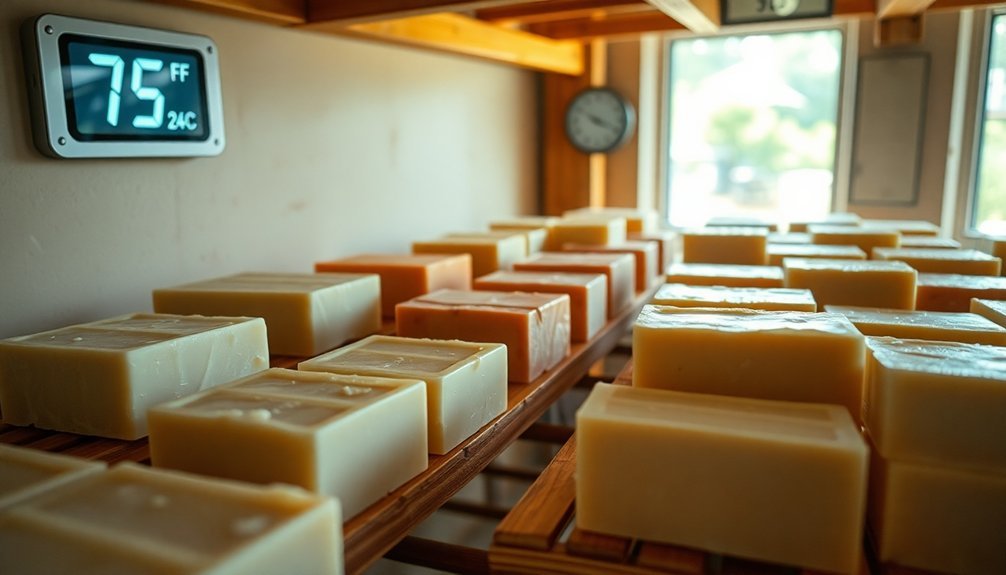
Three vital factors influence successful soap curing, with temperature being perhaps the most important. Your handmade soap requires a suitable temperature range of 60°F to 80°F during the curing process. This range maximizes moisture evaporation while enhancing your soap's overall quality and hardness.
During winter months, curing at the cooler end of this spectrum (low 60s) can actually help prevent Dreaded Orange Spots (DOS) that sometimes appear at higher temperatures. It's essential to maintain stable temperatures, as fluctuations can compromise your soap's quality.
If you're dealing with high humidity levels alongside heat, consider using a dehumidifier to create ideal curing conditions. This combination of temperature and humidity control guarantees proper moisture evaporation, resulting in perfectly cured bars with superior qualities.
The Science Behind Temperature Control in Soap Curing
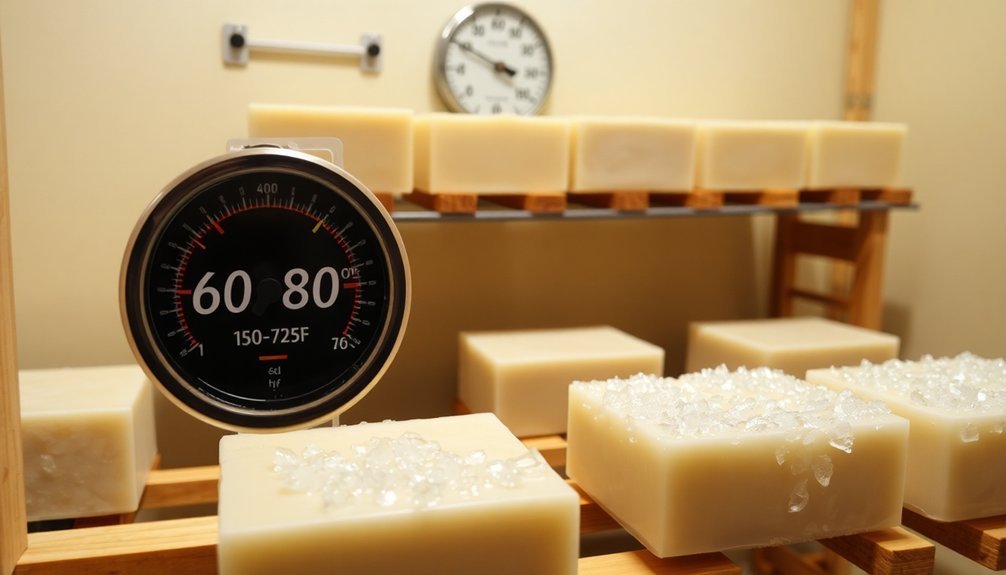
Temperature control affects soap at the molecular level, influencing how oils and lye interact during the final stages of saponification.
You'll find that cooler environments slow this process, creating a more gradual crystallization that often yields harder, longer-lasting bars.
While heat accelerates chemical reactions and moisture evaporation, it's your ability to balance temperature with humidity that ultimately determines whether your soap develops properly or suffers from quality issues.
Heat's Molecular Impact
While many crafters focus on ingredients and molds, understanding the molecular dance occurring during soap curing reveals why temperature control is so essential to your final product.
When you maintain temperatures between 60°F to 80°F, you're actually orchestrating a delicate transformation at the molecular level.
Heat directly affects how your soap's structure stabilizes during curing. The right temperature promotes proper evaporation of excess water while allowing saponification to complete fully. This results in a harder, more effective bar with better longevity.
Temperatures above 91.1°F can disrupt this process, triggering Dreaded Orange Spots (DOS) and other imperfections.
What you're witnessing during curing isn't just drying—it's a complete molecular reorganization that transforms your soft soap into a stable, usable product with ideal cleaning properties.
Cold Saponification Factors
The principles of cold saponification extend beyond simple mixing and pouring—they represent the scientific foundation for your temperature control decisions throughout the curing process.
When saponification is complete, your soap cures most effectively between 60°F and 80°F, allowing excess water to evaporate while preventing DOS formation.
While initial mixing demands 120-130°F for both oils and lye to prevent false trace, the curing phase requires cooler conditions.
Your cold process soap benefits from consistent temperatures that never drop below freezing, as this can cause sweating during thawing and compromise final quality.
Remember that effective air circulation often matters more than precise temperature control.
Proper airflow prevents mold growth and facilitates moisture evaporation, particularly important in humid environments where temperatures approaching 90°F increase DOS risk.
Humidity Versus Temperature
Although soapmakers often focus primarily on temperature readings, humidity plays an equally essential role in the science of soap curing. The relationship between these factors determines how efficiently water evaporates from your soap bars.
While maintaining temperatures between 60°F-80°F is preferable, high humidity can undermine your curing process even at perfect temperatures. Your bars may remain softer longer and develop mold in stagnant, moisture-laden environments.
Conversely, winter's cooler temperatures (low 60s°F) often create superior curing conditions by naturally reducing ambient humidity.
Don't overlook air circulation as the critical third factor in this equation. Even with ideal temperature control, poor airflow traps moisture around your bars, extending curing time unnecessarily.
For best results, maintain stable temperatures, low humidity, and consistent air movement throughout your curing space.
Optimal Temperature Ranges: Finding Your Sweet Spot
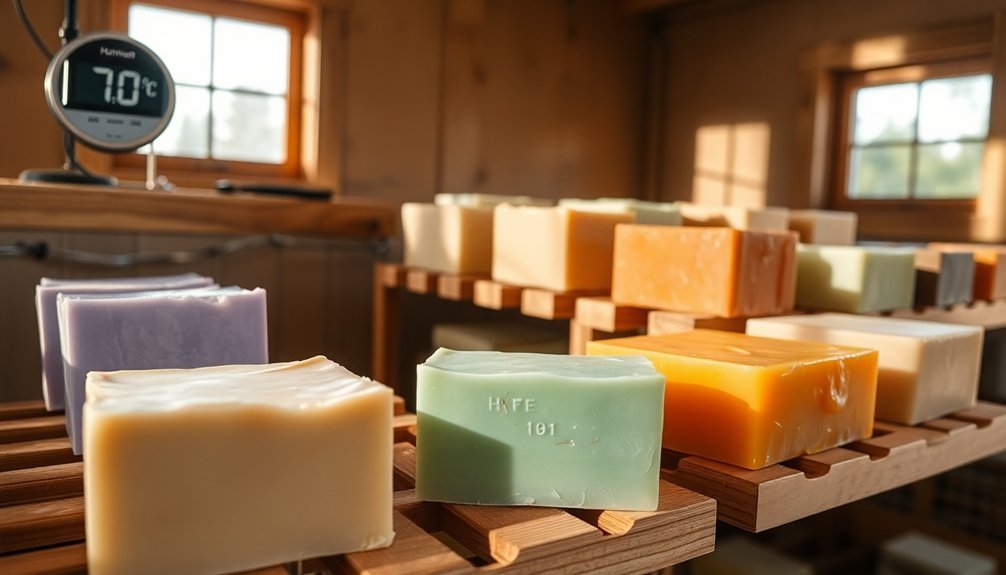
While cold process soaps thrive in the 60°F-80°F range, you'll want to stay closer to the lower end during summer months to prevent DOS formation.
Your hot process bars follow similar guidelines, but can tolerate slight temperature variations better due to their more complete saponification.
Remember that consistent airflow matters more than perfect temperature control, especially when you're working in naturally cooler environments.
Cold Process Guidelines
Finding your soap's ideal curing temperature can make the difference between a perfect bar and one plagued with issues. For cold process soap, aim to maintain temperatures between 60°F and 80°F throughout the curing period. This range guarantees peak moisture evaporation while preserving your soap's quality.
Temperature monitoring becomes essential when conditions exceed 80°F, as higher temperatures greatly increase the risk of Dreaded Orange Spots (DOS), especially in humid environments. To combat this, improve air circulation around your curing soaps with fans or ventilation systems, which helps moisture evaporate evenly.
During summer months, seek cooler spots in your home for curing. Avoid exposing your bars to temperature extremes—too cold slows the curing process, while excessive heat can cause sweating and quality issues.
Hot Process Considerations
The three critical temperature zones for hot process soap curing each produce distinctly different results.
When you maintain temperatures between 120°F-160°F, you'll achieve the ideal temperature range that promotes a successful gel phase, enhancing both color and texture in your final bars.
Keeping your soap above 130°F helps prevent soda ash formation, improving aesthetic appeal without affecting functionality.
Though higher temperatures accelerate saponification, be cautious—excessive heat can cause glycerin rivers or soap volcanoes if not properly managed.
Experienced soap makers know that temperatures below 110°F can inhibit proper curing, resulting in longer drying times and potential moisture issues.
Consider experimenting with different temperature ranges within the recommended spectrum to discover which setting yields your preferred characteristics for specific recipes.
Basement vs. Closet: Evaluating Your Curing Space Options
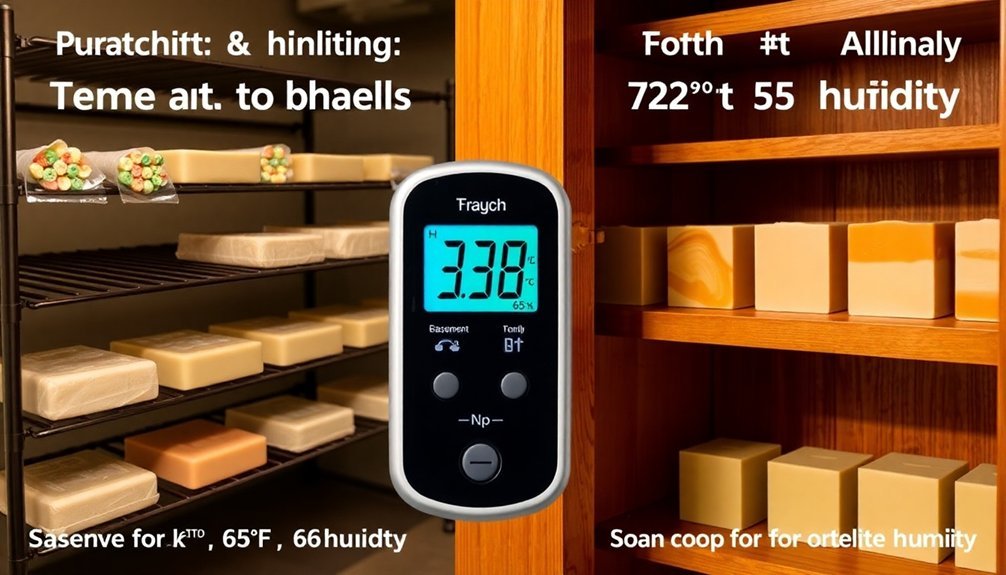
When selecting a curing space for your handmade soap bars, basements and closets offer distinct advantages that can greatly impact your final product.
Basements typically maintain cooler temperatures in the low 60s during winter, ideal for curing soap and preventing DOS in warmer months. Closets run warmer at 65-68°F in winter and 75-79°F in summer, which may be less favorable.
Air flow trumps temperature for effective curing, with basements often providing better ventilation on open racks compared to closets' limited circulation.
However, humidity levels require monitoring in both locations—basements tend to be damper while closets offer drier conditions. If you choose a basement, consider using dehumidifiers to control moisture.
Your decision should prioritize consistent temperature range and adequate air circulation for properly cured bars.
Managing Seasonal Temperature Fluctuations During Curing
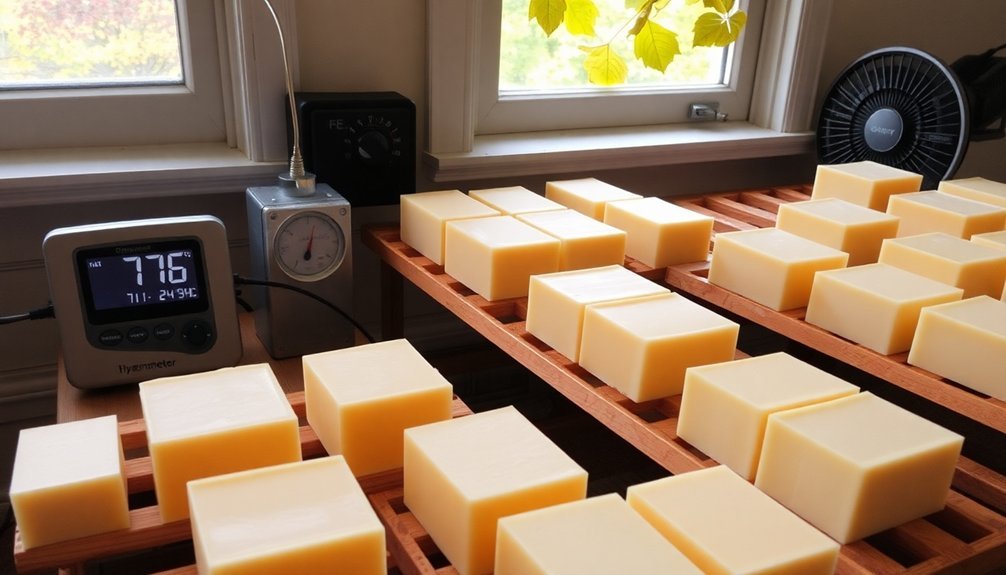
Seasonal shifts pose distinct challenges for soap makers committed to proper curing. You'll need to adjust your approach as weather patterns change throughout the year.
| Season | Recommended Actions |
|---|---|
| Winter | Maintain curing temperatures between 60°F-68°F; utilize basement spaces |
| Spring | Monitor rising humidity levels; introduce fans for improved air circulation |
| Summer | Keep temperatures below mid-80s°F; employ dehumidifiers to prevent DOS |
| Fall | Adjust gradually as temperatures drop; prevent extreme temperature fluctuations |
During winter months, your basement offers perfect conditions, while summer requires vigilance against excessive heat and humidity. Temperature fluctuations below freezing are particularly problematic, causing soap to sweat when thawing. Regular environment checks are essential—adjust fan placement, dehumidifier settings, and storage locations to maintain ideal curing conditions year-round. Remember that consistent air circulation helps manage humidity levels effectively, regardless of season.
The Relationship Between Air Flow and Temperature
Although temperature maintenance remains important during curing, proper air circulation actually plays the more vital role in determining your soap's final quality.
When you prioritize air flow during the curing process, you're enabling efficient moisture evaporation that prevents common issues like mold and DOS.
- Natural ventilation in open-rack setups provides ideal conditions for even moisture distribution
- High humidity environments require additional air circulation measures, such as fans
- During early curing stages, increased air movement greatly accelerates the drying process
- While temperature should stay between 60°F-80°F, adequate air flow remains essential regardless
- Well-ventilated spaces like basements with natural air movement offer excellent curing environments
Temperature Danger Zones: When Heat Becomes Problematic
Despite its essential role in the curing process, heat beyond certain thresholds can sabotage your soap's quality. When temperatures climb above 80°F, you're entering temperature danger zones where Dreaded Orange Spots (DOS) become increasingly likely to develop in your handmade bars.
Temperatures exceeding 91.1°F pose significant risk, potentially accelerating DOS formation and compromising your soap's integrity. High humidity levels compound these heat-related issues, creating a perfect storm for quality problems.
Your curing environment should ideally remain between 60°F and 80°F, with proper dehumidification to prevent moisture complications.
If you're dealing with warmer conditions, employ a fan to improve air circulation. This simple solution can help mitigate heat-related issues by promoting even drying and reducing the likelihood of temperature-induced defects during the curing process.
Cold Weather Curing: Preventing Moisture Issues
When temperatures drop, your soap faces a different set of challenges during the curing process. Cold weather curing requires vigilant attention to prevent moisture issues that can compromise your bars.
Maintaining temperatures between 60°F-80°F is vital, with basements often providing ideal conditions in winter months.
For successful cold weather curing:
- Monitor humidity levels consistently to prevent DOS formation
- Guarantee proper air circulation around each soap bar
- Consider placing your curing racks in a basement where temperatures remain in the low 60s
- Use a fan to improve air movement and encourage moisture evaporation
- Keep bars spaced adequately to prevent humidity trapping between them
Remember that stagnant air combined with cold temperatures can exacerbate moisture problems, so proper ventilation becomes even more critical during winter months.
Monitoring Tools for Maintaining Ideal Curing Conditions
Successful soap curing depends not just on recognizing temperature challenges but also on having the right tools to measure and control your environment. A reliable thermometer is essential for tracking temperatures, ensuring your soap cures within the preferred 60°F-80°F range.
Don't overlook humidity control—a hygrometer becomes your best ally in preventing mold and DOS.
Digital monitoring tools offer real-time temperature and humidity readings, allowing you to make immediate adjustments when conditions drift from ideal.
Enhance air circulation with a fan or humidity-controlled air purifier to maintain consistent conditions throughout your curing space.
Keep a simple log of your readings to identify patterns and refine your process over time.
These monitoring tools aren't just nice-to-have accessories—they're fundamental to consistent, high-quality soap production.
Frequently Asked Questions
What Temperature Range Is Ideal for Curing?
For curing, you'll want a temperature range between 60°F and 80°F. You should aim for the cooler end (low 60s) to prevent DOS. Using a dehumidifier helps maintain these temperatures in humid environments.
What Is the Best Temperature for Curing Soap?
The best temperature for curing soap is between 60°F-80°F. You'll get ideal results in cooler conditions within this range, as they'll prevent DOS issues while enhancing moisture evaporation for a harder, longer-lasting bar.
What Is the Optimum Temperature for Saponification?
For saponification, you'll want both your oils and lye solution between 120-130°F. Keep them within 10 degrees of each other to prevent false trace and guarantee proper chemical reaction during the mixing process.
What Is the Best Temperature for Cured Resin?
For cured resin, you'll want to maintain temperatures between 70-80°F (21-27°C). This range guarantees ideal hardening while preventing bubbles or incomplete curing. Don't let it drop below 65°F or exceed 85°F for best results.
In Summary
Maintain your soap bars between 60-80°F (15-27°C) for ideal curing. You'll find better results with consistent temperatures and moderate airflow than with perfect conditions that fluctuate. If you're working in extreme seasons, consider investing in a simple thermometer and hygrometer. Remember, patience pays off—properly cured bars at the right temperature will reward you with longer-lasting, better-performing soap.

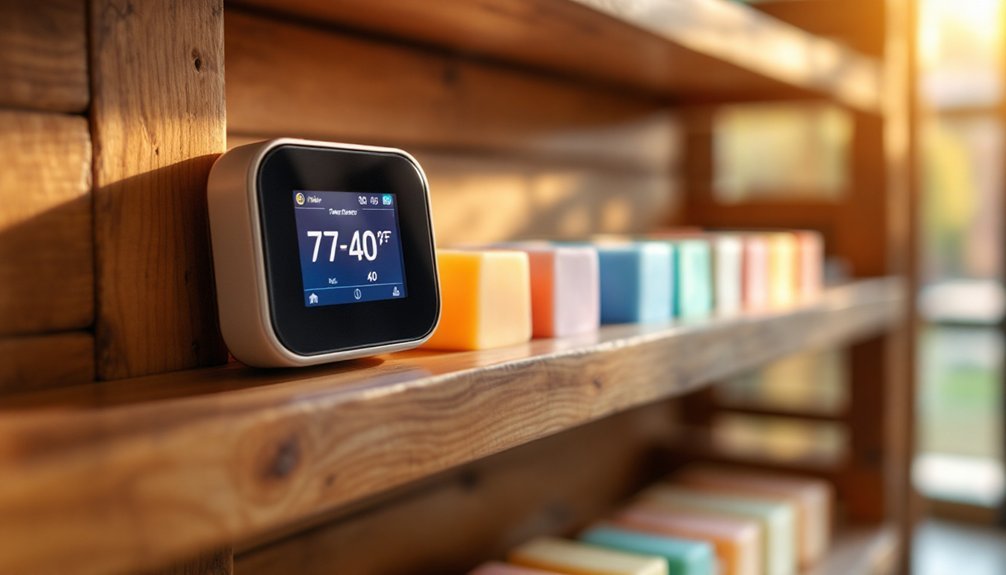



Leave a Reply